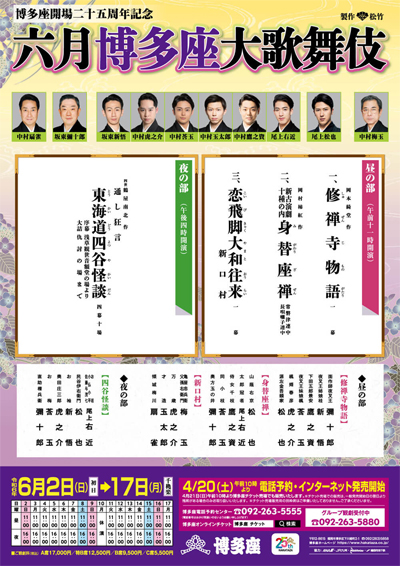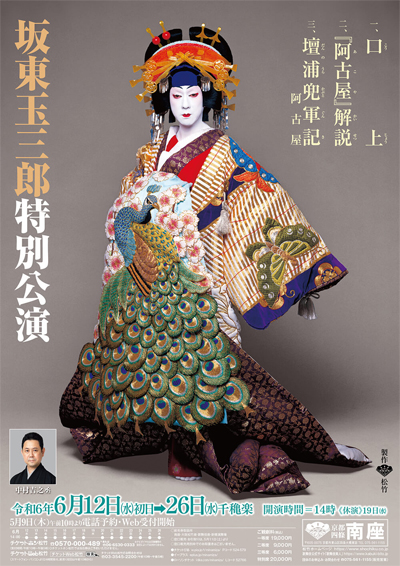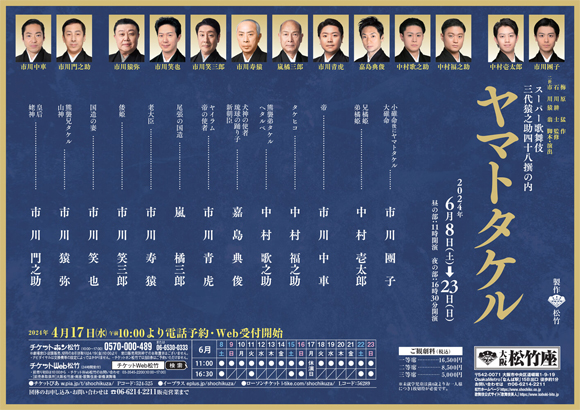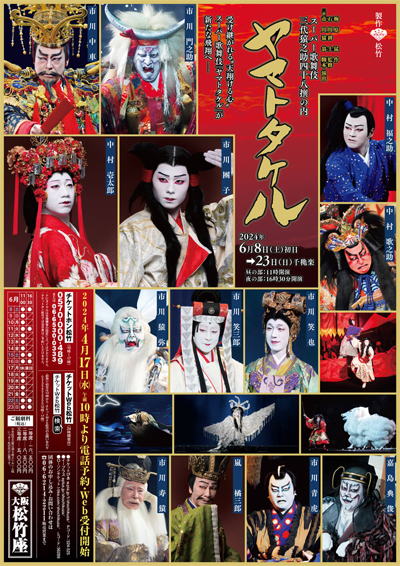| JUNE 2024 |
| Kabukiza (T˘ky˘) |  |
| Dates | 1 ~ 24 June 2024 Rokugatsu ďkabuki June Grand Kabuki |
| MatinÚe |
Yoshitsune Senbon Zakura |
| Evening |
Nans˘ Satomi Hakkenden (Maruzukayama) Yamanba |
| Casting |
Living National Treasure Onoe Kikugor˘, Living National Treasure Kataoka Nizaemon, Living National Treasure Nakamura Karoku, Nakamura Manju, Nakamura Shikan, Onoe Kikunosuke, Nakamura Shichinosuke, Nakamura Kinnosuke, Nakamura Shid˘, Nakamura Tokiz˘, Onoe Sh˘roku, Kataoka Takatar˘, Nakamura Matagor˘, Nakamura Hayato, Band˘ Minosuke, Nakamura Kotar˘, Band˘ Kamez˘, Nakamura Mantar˘, Nakamura Yonekichi, Nakamura Kash˘, Nakamura Tanenosuke, Nakamura Hashinosuke, Ichikawa Somegor˘, Ichimura Manjir˘, Kawarasaki Gonjűr˘, Matsumoto Kingo, Onoe Sakon, Ichikawa Otora, Nakamura Baishi, Nakamura Haruki, Nakamura Natsuki |
| Comments |
The 2 programs for the June Grand Kabuki at the Kabukiza with important events for the Yorozuya guild:
|
 |
 |
|
|||
| Dates | 2 ~ 17 June 2024 Rokugatsu Hakataza ďkabuki June Hakataza Grand Kabuki |
||
| MatinÚe | |||
| Evening | |||
| Casting |
Living National Treasure Nakamura Baigyoku, Band˘ Yajűr˘, Nakamura Senjaku, Onoe Matsuya, Onoe Ukon, Band˘ Shingo, Nakamura Takanosuke, Nakamura Kangyoku, Nakamura Toranosuke, Nakamura Tamatar˘ |
||
| Comments |
The traditional two programs for the June Grand Kabuki at the Hakataza.
|
||
 |
 |
| Misonoza (Nagoya) |  |
| Dates | 1 ~ 9 June 2024 Band˘ Tamasabur˘ Tokubetsu K˘en Band˘ Tamasabur˘ Special Performances |
| Program | |
| Casting |
Living National Treasure Band˘ Tamasabur˘, Kataoka Ainosuke, Kamimura Kichiya, Nakamura Kichinoj˘, Nakamura Kamenoj˘ |
| Comments |
A special program starring the amazing Living National Treasure onnagata Band˘ Tamasabur˘ in Nagoya at the Misonoza.
|
 |
|
|||
| Dates | 12 ~ 26 June 2024 Band˘ Tamasabur˘ Tokubetsu K˘en Band˘ Tamasabur˘ Special Performances |
||
| Program |
Akoya Kaisetsu Dan no Ura Kabuto Gunki (Akoya) |
||
| Casting |
Living National Treasure Band˘ Tamasabur˘, Nakamura Kichinoj˘, Kataoka Senjir˘, Band˘ K˘ichi |
||
| Comments |
A special program starring the amazing Living National Treasure onnagata Band˘ Tamasabur˘ in Ky˘to at the Minamiza.
|
||
 |
| Sunpearl Arakawa (T˘ky˘) |  |
| Dates | 1 ~ 21 June 2024 Rokugatsu Kabuki Kansh˘ Ky˘shitsu June Kabuki Appreciation Class |
| Program |
Kabuki no Mikata |
| Casting |
Nakamura Ganjir˘, Ichikawa Komaz˘, Band˘ Hikosabur˘, Nakamura Kikaku, Nakamura Jűjir˘, Nakamura Gansei |
| Comments |
Educational program at the Sunpearl Arakawa, instead of the at the National Theatre (rebuilding ongoing), called Kabuki Kansh˘ Ky˘shitu ("Kabuki Appreciation Class"). This is the 105th edition and a very interesting formula for the beginners because there is lively presentation on stage (Kabuki no Mikata) of Kabuki or some aspects of the art like music, stage tricks or fighting scenes. It is followed by "Fűin Giri".
|
| Sh˘chikuza (ďsaka) |  |
| Dates | 6 ~ 23 June 2024 |
| Program | |
| Casting |
Ichikawa Chűsha, Ichikawa Danko, Ichikawa Monnosuke, Nakamura Kazutar˘, Ichikawa En'ya, Ichikawa Emisabur˘, Ichikawa Emiya, Ichikawa Juen, Ichikawa Seiko, Nakamura Fukunosuke, Nakamura Utanosuke, Arashi Kitsusabur˘, Kashima Noritoshi |
| Comments |
Revival of the famous SűpÔ Kabuki drama "Yamato Takeru", a classic of the Omodakaya guild, in ďsaka at the Sh˘chikuza. In the absence of Ichikawa Ennosuke, the eponymous role of Yamato Takeru is played by Ichikawa Ennosuke III's grandson Ichikawa Danko.
|
 |
 |
| Sh˘chiku Special Kabuki Tour | |
| Dates | 30 June ~ 31 July 2024 Sh˘chiku Tokubetsu Kabuki Sh˘chiku Special Kabuki |
| Program |
Nakamura Shid˘ no HOW TO Kabuki |
| Casting |
Nakamura Shid˘, Nakamura Tanenosuke, Sawamura Kuniya, Nakamura Ch˘ichi, Nakamura Ch˘shi, Nakamura Haruki |
| Comments |
A Sh˘chiku Special Kabuki Summer Tour led by Nakamura Shid˘.
|
 |
| Kanagawa Prefectural Youth Center Momijizaka Hall (Yokohama) |  |
| Dates | 23 ~ 24 June 2024 Rokugatsu Kabuki Kansh˘ Ky˘shitsu June Kabuki Appreciation Class |
| Program |
Kabuki no Mikata |
| Casting |
Nakamura Ganjir˘, Ichikawa Komaz˘, Band˘ Hikosabur˘, Nakamura Kikaku, Nakamura Jűjir˘, Nakamura Gansei |
| Comments |
Educational program in Yokohama at the Kanagawa Prefectural Youth Center Momijizaka Hall, instead of the at the National Theatre (rebuilding ongoing), called Kabuki Kansh˘ Ky˘shitu ("Kabuki Appreciation Class"). This is the 105th edition and a very interesting formula for the beginners because there is lively presentation on stage (Kabuki no Mikata) of Kabuki or some aspects of the art like music, stage tricks or fighting scenes. It is followed by "Fűin Giri".
|
| Shizuoka Convention & Arts Center Granship (Shizuoka) |  |
| Dates | 26 June 2024 Rokugatsu Kabuki Kansh˘ Ky˘shitsu June Kabuki Appreciation Class |
| Program |
Kabuki no Mikata |
| Casting |
Nakamura Ganjir˘, Ichikawa Komaz˘, Band˘ Hikosabur˘, Nakamura Kikaku, Nakamura Jűjir˘, Nakamura Gansei |
| Comments |
Educational program in Shizuoka at the Shizuoka Convention & Arts Center Granship, instead of the at the National Theatre (rebuilding ongoing), called Kabuki Kansh˘ Ky˘shitu ("Kabuki Appreciation Class"). This is the 105th edition and a very interesting formula for the beginners because there is lively presentation on stage (Kabuki no Mikata) of Kabuki or some aspects of the art like music, stage tricks or fighting scenes. It is followed by "Fűin Giri".
|
|
|
| Contact | Main | Top | Updates | Actors | Plays | Playwrights | Programs | Links | FAQ | Glossary | Chronology | Illustrations | Prints | Characters | Derivatives | Theaters | Coming soon | News |
